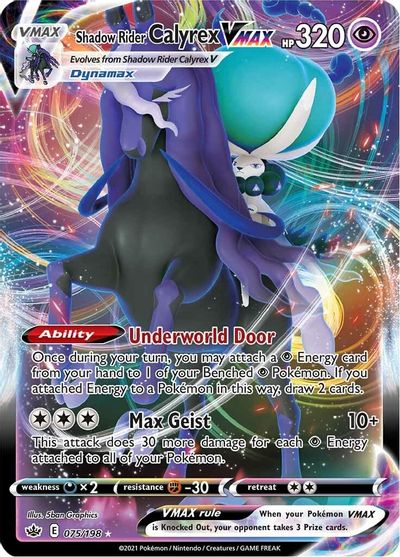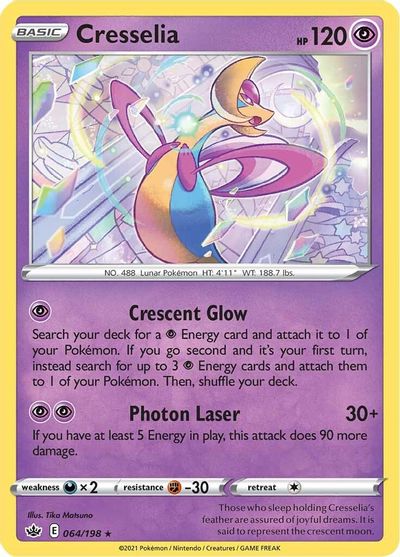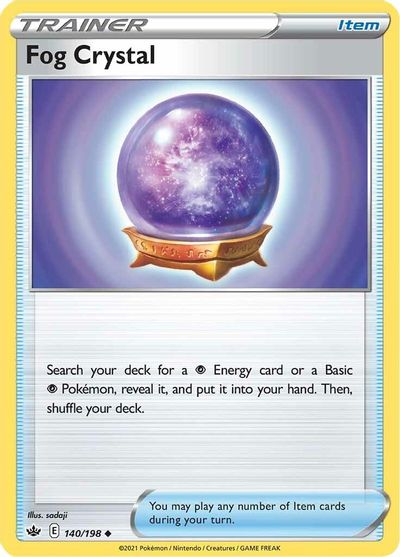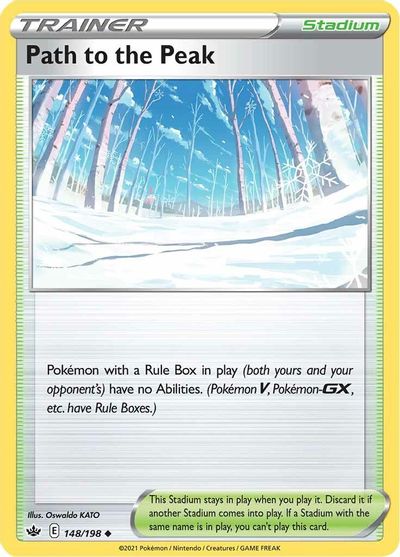Hello again Flipside readers! The official tournament legality for our latest set, Chilling Reign, is not far away, so I figured now would be a smart time to start looking at the upcoming Standard format and how it will be impacted by the cards from the new set.
While there are a lot of new cards to be excited about, in this article I’ll just focus on perhaps the two most important ones from Chilling Reign: Shadow Rider Calyrex VMAX and Path to the Peak. While both these cards are extremely strong individually, they are also noteworthy because they can pair together in a new archetype that I expect to become top-tier in the next Standard format. In this article I’ll break down each of these cards in detail, drawing on a bit of game history to explain why they’re so good, and then I’ll present a decklist that uses them both together, which I think will be a great starting point for competitive play with Chilling Reign legal.
Shadow Rider Calyrex VMAX

I remember when we first received the translation for this card. It was about 4 in the morning in my time zone but I had stayed awake in anticipation of the reveal— as had Rahul Reddy, who was streaming on Twitch to discuss the new translations. There was a buzz of excitement in the Twitch chat when we got the translation for Shadow Rider Calyrex VMAX. Its damage scaled with each [P] Energy you put into play, reminding us of archetypes like Turbo Darkrai-EX or the newer Zoroark & Greninja-GX build in Expanded. Its Ability “cheated” an extra [P] Energy into play each turn, akin to Abilities on Pokemon that have been very strong in recent years such as Eelektrik, Bronzong, Malamar, and Gardevoir-GX. However, it had been several minutes before any of us realized that the first translation had not been a full translation, and half of the Ability was missing: the Underworld Door Ability also let you draw 2 cards upon attaching the Energy.
Understandably, Rahul’s chat went crazy after that, since it was now apparent that Shadow Rider Calyrex VMAX combined aspects of three of the strongest archetypes to grace the Pokemon TCG in recent years. It is Turbo Dark, Malamar, and Zoroark-GX combined in a single card. On paper, it wouldn’t be insane to suggest that this is one of the strongest Pokemon that has ever been printed.

Chilling Reign also introduces a Cresselia that acts similarly to Volcanion from Unbroken Bonds: it accelerates three [P] Energy into play on your first turn if you go second. This is obviously intended to pair with Shadow Rider, and indeed many players first expected that Shadow Rider would exist as a Turbo Dark-style deck, accelerating a large number of Energy into play very quickly and hitting for a high amount of damage. This deck would certainly be good, but it was not long before players realized there is likely an even better way to play Shadow Rider: pairing it with Trevenant & Dusknoir-GX. That is the deck I will feature at the end of this article, and I expect the deck to be perhaps not just dominant, but oppressive in Standard as soon as it is legal. To understand why, we need to look at the complete picture and examine the other incredibly strong card from Chilling Reign: Path to the Peak.
Path to the Peak
Path to the Peak is a Stadium that simply turns off Abilities on all Pokemon in play that have Rule Boxes. In recent years, we’ve seen incredible success from similar Stadiums, such as Silent Lab (Basic Pokemon have no Abilities) and Power Plant (Pokemon-EX and -GX have no Abilities), but Path to the Peak is perhaps the strongest of them all, since the number of Pokemon with Rule Boxes is incredibly high in competitive play; almost all decks rely on Pokemon with both Abilities and Rule Boxes to some extent. Thus, it seems almost guaranteed that Path to the Peak will see a huge amount of play in Standard as soon as it is legal.
Even if you have only been playing the Pokemon TCG for a short time, you probably understand how oppressive it can be to have no access to Abilities as soon as the first turn of the game. Decks with high counts of Silent Lab or Wobbuffet PHF took advantage of this in past formats, often in slower archetypes that needed the opponent to miss a beat or two so they could set everything up. Decks that could combine Power Plant with Marshadow SHL were also strong (like Buzzwole/Garbodor in Expanded), combining early Ability lock with early hand disruption. (As you’ll see in a moment, that combination of Power Plant and “Let Loose” Marshadow was the inspiration for the deck I’m about to profile.)
With the way the Pokemon TCG’s design has trended in the past couple of years, I worry about the influence of Path to the Peak, and I know I’m not alone in this fear, with a lot of very good players expecting this new Stadium to be incredibly powerful and even format-warping. For better or worse, the game design over the past few years has favored fast, high-RNG, heavy-hitting archetypes that use a high number of draw-support Pokemon (Dedenne-GX and Crobat V especially) to dig for big combos of cards and win games in just a few turns. The emphasis here is on those support Pokemon, which invariably are Pokemon with Rule Boxes--i.e., they are shut off by Path to the Peak. If you are playing one of those decks and your opponent plays down a Path to the Peak before you have even taken your first turn, your deck may suddenly find itself completely crippled. If you cannot play Dedenne-GX or Crobat V, you will need to have a Supporter card in your hand to even see cards, and chances are high your setup will not be as good as what your opponent will be able to achieve.


In the past, formats were sometimes able to adjust to extremely strong new cards--for example, after the release of Garbodor in Guardians Rising, decks moved quickly towards higher Supporter counts and lower Item counts to play around the format-warping Trashalanche attack. (This actually led to a minor golden age of Pokemon TCG, as the decrease in Items made most decks less “turbo” and created longer games, and therefore more thoughtful and interactive gameplay.) However, the issue with our current Standard format is that it is quite difficult to build decks that don’t rely on Dedenne-GX and Crobat V. We just don’t have the card pool to build lists that can execute slower and more methodical strategies (Control decks notwithstanding) when we need to compete with three-Prize Pokemon on the other side of the board.
The extreme power of Path to the Peak, combined with what I think is a significant lack in counterplay, looks like an overall negative for the Standard format in my opinion. Just as players in 2019 complained about instantly losing to a turn one Let Loose, I expect hundreds of complaints to roll in about players being unable to play the game because their opponent went first and played Path to the Peak. We do have Marshadow with the Reset Hole Ability, and certainly decks can always play counter Stadiums, but there is no guarantee you will be able to find those cards early (and then still find everything else you need to set up). The problem is especially compounded when you combine Path to the Peak with another often-maligned form of disruption in the Pokemon TCG: hand disruption. That combo is the focus of the last part of this article.
Deck profile: Shadow Rider Calyrex VMAX/Trevenant & Dusknoir-GX/Path to the Peak
Before I go further, let me just state that someone needs to come up with a nickname for this archetype fast, because that name is way too much to type more than once. I’ll just call the deck “Shadow Rider” here.

As I mentioned, this deck isn’t the immediately obvious way to play Shadow Rider Calyrex VMAX (as an OHKO deck with Energy acceleration from Cresselia), but based on similar concepts from recent years, I think it will prove to be the stronger build. This deck takes inspiration from the Buzzwole/Garbodor/Power Plant deck of 2018-2019 Expanded (I believe it also saw some play in Standard); the oppressive Trevenant & Dusknoir-GX/Milotic deck that Justin Bokhari used to win the last Regional before the COVID-19 pandemic; and my teammate Le Bui’s “Zoroark-GX Exodia” deck that he brought to Top 4 of a Regional in 2018.
All of those decks combined some kind of hand disruption with some kind of Ability lock. Buzzwole/Garbodor/Power Plant was a little weaker and didn’t have incredible success, but I remember a lot of players complaining about how horrible it was to play against because of the Let Loose + Power Plant combo bricking them out of the game. The TrevNoir/Milotic deck terrorized Collinsville Regionals, with almost nothing being able to stand up to its capability of completely locking the opponent out of the game regardless of who went first or second. Le’s Zoroark-GX deck was strong enough to demolish a number of extremely strong players en route to his Top 4 Regional finish in just his first season competing, a testament to how annoying its turn one hand lock was, followed by the Ability lock of Alolan Muk if needed.

The 2021 iteration of this hand lock + Ability lock concept is formed by combining the hand disruption of Marnie and TrevNoir’s Night Watch attack with Path to the Peak. Shadow Rider Calyrex VMAX is the glue that holds the concept together. On the first turn of the game, you must simply find a Shadow Rider Calyrex V and attach a [P] Energy to TrevNoir. On your second turn, you can attach again to TrevNoir, evolve to Shadow Rider Calyrex VMAX, and use Underworld Door to attach the third Energy needed to use Night Watch. You also have the bonus effect of those +2 cards drawn to continue to build up your hand and board, and if you’re able to get multiple VMAX into play, you can accelerate even more Energy and draw even more cards. You’ll end your second turn by playing Marnie, slamming down Path to the Peak, and announcing Night Watch. Your opponent will begin their turn with three cards (none of which they were holding from last turn) and no access to Abilities on Rule Box Pokemon. Most likely, they will need a stroke of luck to get back into the game from that point.
Here is a preliminary list to get you started on building Shadow Rider. I’ve aimed for pure consistency and no techs here; there will be room to consider those as you test matchups and as the format develops.
A couple of notes:

The interesting twist in this list comes from the count of three Marshadow with that Reset Hole Ability. This enables you to remove your own Path to the Peak, use Underworld Door as much as you like (or perhaps Dedechange if you didn’t use that in the first two turns), and then play down a second Path to the Peak before you finish your turn. This “Abilities for me but not for you” strategy was used in several Zoroark-GX/Garbodor lists from a few years back that either used Klefki STS to activate Garbotoxin each turn only when you’d finished using Trade as much as you wanted, or played a high count of Field Blower for the same reason. Marshadow gives us a way to replicate that in current Standard and ensures that you have access to the full power of your deck while your opponent’s deck is crushed by your hand disruption and Ability lock.
Cresselia is not as essential here as in a pure Shadow Rider OHKO deck, but Crescent Glow is by no means a bad attack to use on your first turn if you go second; it can completely power up a TrevNoir or just get more Energy in play to make Max Geist do more damage later. It’s also probably needed as a non-GX or -V attacker to deal with Altaria and Decidueye.

One of the key cards in this archetype is another new Chilling Reign card, Fog Crystal. With no drawbacks, this card searches for any Pokemon in the deck barring Dedenne-GX, and can also sometimes find you a Psychic Energy if you whiffed one. Because the goal of this list is to be extremely consistent and ensure you always set up and achieve the turn two lock on your opponent, four Fog Crystal are perfect to ensure you never miss out on TrevNoir and the Shadow Rider line early, and can help find Marshadow later if you’d like your Abilities back for a turn.
In conclusion, this deck is not fair and not fun. It is very simple to play and it is capable of locking essentially any deck out of the game before they have had more than one turn to execute their strategy. However, decks of this nature have existed before, and you need to know how to play against them (to the extent that one can) if you want to succeed competitively. I think the list I’ve presented here is a good starting point to begin testing other archetypes against, and seeing if any particular decks, techs, or strategies can help you gain an edge over its disruptive power.
I’ll be back later this month with a look at another new archetype and some thoughts on the metagame in our latest Standard format. Until then, good luck with your testing and tournaments, and as usual you can find my team on Twitter @UNDNTD, and me personally at @twhitesell42, where I’m always happy to chat. See you soon!














